Kaziranga National Park & Tiger Reserve Assam, India
Kaziranga National Park is a must-visit for those intrigued by the existence of Indian one-horned rhinoceros, once thought to be from the Jurassic era. Covering 430 square kilometers, it houses over 2200 of these rhinoceros, about two-thirds of the global population. Established in 1908 on Mary Curzon’s recommendation, the park became a UNESCO World Heritage Site in 1985. Mary Curzon’s visit to a rhinoceros-less park prompted her to initiate protection measures, leading to the creation of the Kaziranga Proposed Reserve Forest in 1905. This wildlife haven is also a breeding ground for elephants, wild water buffalo, and swamp deer. Over time, tiger numbers have increased, resulting in its declaration as a Tiger Reserve in 2006. Recognized by BirdLife International as an Important Bird Area, Kaziranga attracts migratory birds from Central Asia during winter. Beyond its animal population, the park is renowned for its wildlife conservation initiatives, particularly for the Greater one-horned rhinoceros, an endangered species. The park’s scenic beauty, featuring tall elephant grass, marshlands, and lush forests, is complemented by the presence of the enigmatic Brahmaputra River.Kaziranga National Park stands as a beacon of pride for India, where nature reveals its untouched beauty in myriad hues and wildlife thrives in its natural habitat. Located in the northeastern region of the country, within the districts of Golaghat and Nagoan in the state of Assam, this esteemed national park has a rich history dating back to its establishment in 1904 as a wildlife sanctuary. Nearly seven decades later, it earned the distinguished status of a National Park, solidifying its place as a sanctuary where man and nature coexist harmoniously.
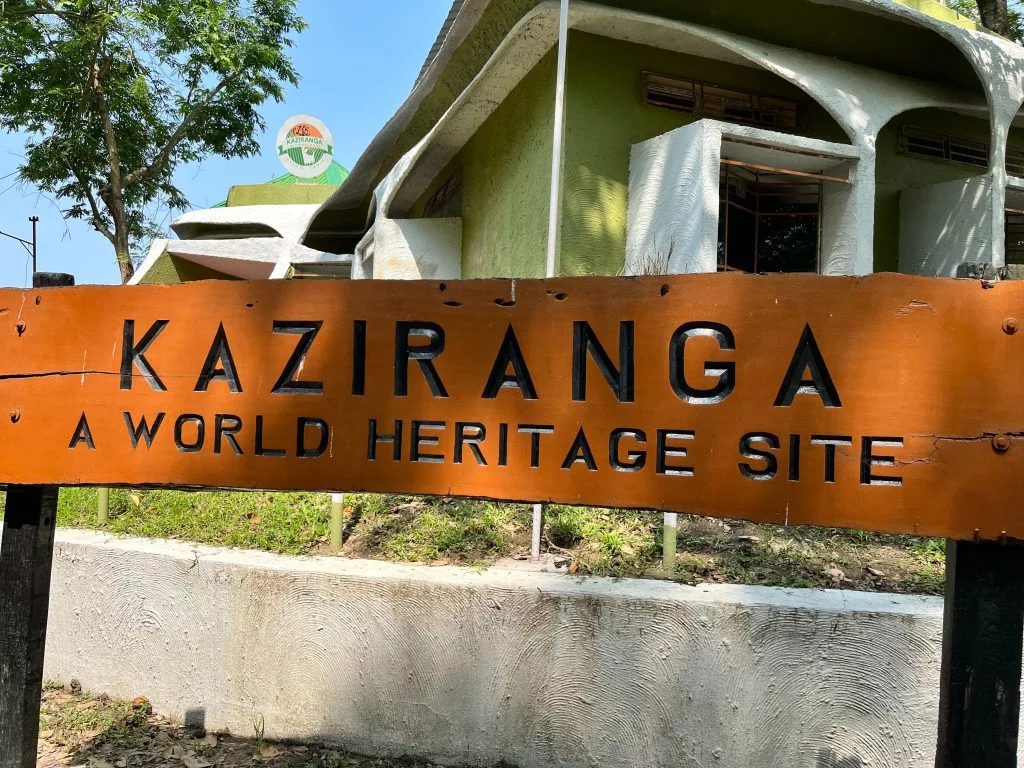
Wildlife Tour Package | Kaziranga National Park, Assam
4 Nights / 5 Days Guwahati & Kaziranga Tour Package
Kaziranga Tour Itinerary –
day 1 – Arrive in Guwahati & Transfer to Kaziranga National Park
On arrival at Guwahati Airport, you will be picked and dropped by us only when your resort is in 5 km radius and also you are doing jeep safari only. If you are doing elephant safari then pick and drop facility won’t be on us. Now check in to your pre-booked hotel nearby Kaziranga and take a rest for a while and if you feel like wandering nearby villages or Orchid Garden then avail that privilege. After dinner, overnight stay at Kaziranga.
Day 2 – Jeep Safari & Jeep Safari at Kaziranga National Park
Once you wake up have your breakfast then move for the jeep safari. While during jeep safari you can spot one-horned rhino, white buffalo, hog deer, and many more. Get back to the hotel and get into lavishing lunch. After your lure lunch takes a rest for a while then is ready for the late afternoon jeep safari into the deep forest.
You can have your family moment with a wildlife jeep safari. After successful completion of the safari, you can go few famous places nearby. Celebrate the beginning of a splendid holiday in the jungle and be in awe of its scenic beauty. Afterward, retire to your cozy room for the best sleep.
Day 3 – Check out & Drop at Guwahati Airport
Start your day with a tempting and light breakfast then you can utilize this time for tea garden visit. Also, you can do the same after checking out from the hotel and proceed towards a few amazing places if time permits. Upon completion of your city tour, you can go to Guwahati Airport so your trip will end with the best memory.
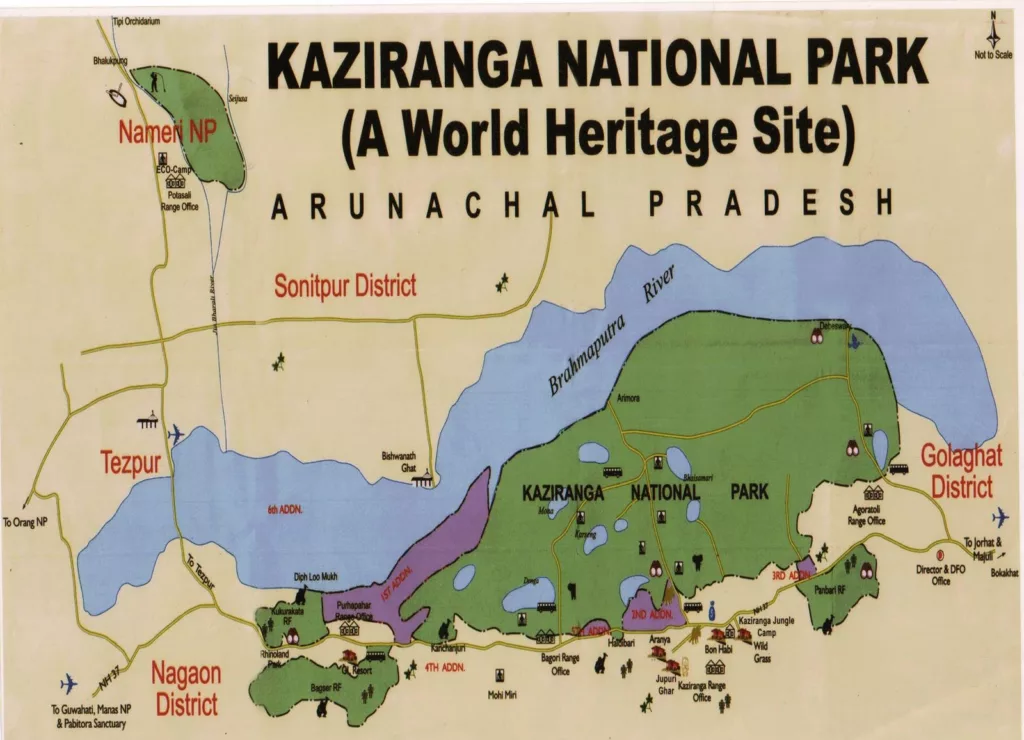
Kaziranga National Park and Tiger Reserve
Kaziranga National Park: Safari Booking Guide, Procedures, & Expert Tips
Kaziranga National Park, home to one-third of the world’s One-horned rhinos, is a must-visit destination for nature enthusiasts. It offers exciting safaris to witness majestic animals like Tigers, Elephants, and Rhinos. You can explore this semi-evergreen forest on an off-roading gypsy or an elephant ride. Birdwatchers will love it for its rare and migratory bird species. Located by the Brahmaputra River, Kaziranga’s stunning landscapes are awe-inspiring. Get ready for an adventure with our Kaziranga National Park safari booking information.
Types of Safaris Offered in Kaziranga National Park
Kaziranga National Park offers two types of safaris:
- Jeep Safari
- Elephant Safari
Jeep Safari in Kaziranga
Explore Kaziranga’s wildlife on a thrilling Jeep safari, ideal for nature enthusiasts. Traverse rugged off-road trails, meadows, dense forests, and lakeside bridges. Daily safaris in limited numbers safeguard both animals and tourists, offered morning and evening for two hours each. Discover wildlife while preserving the natural ecosystem, thanks to designated jeep paths in every zone of Kaziranga National Park.
*Please note: The Jeep safari operates on an exclusive basis, accommodating a maximum of 5 individuals in one vehicle. Children under 4 years can join without any charge, but those aged 4 and above are considered adults and are billed for a full seat.
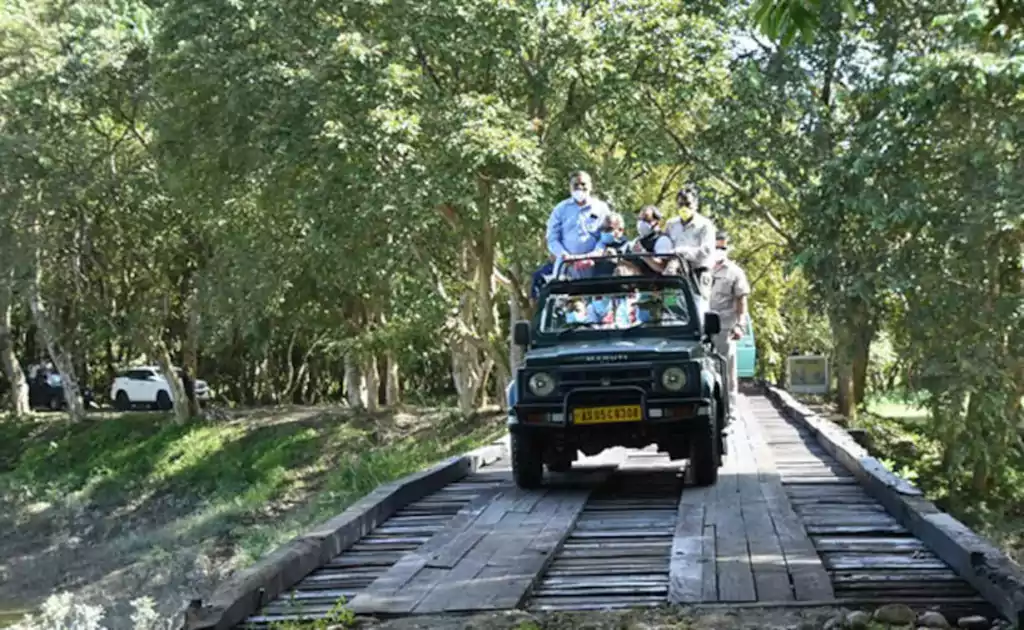
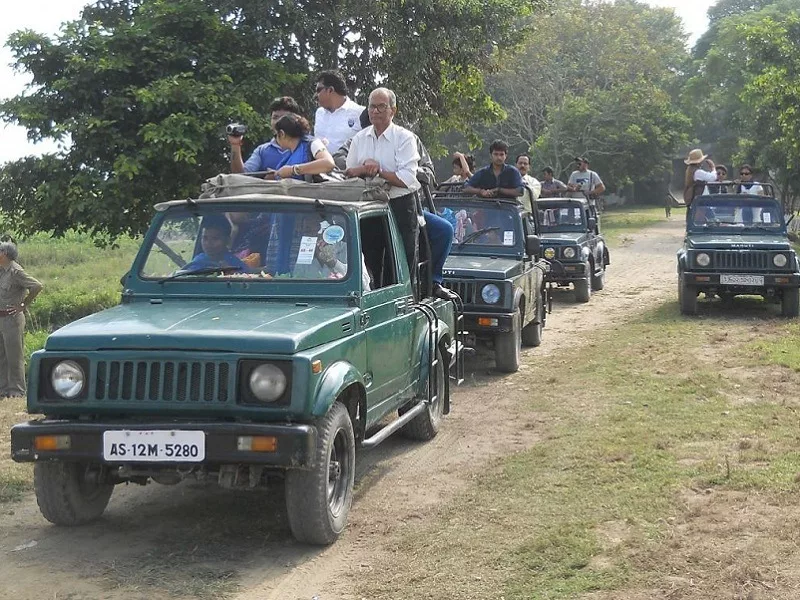
Elephant Safari in Kaziranga
Explore Kaziranga National Park in a truly exceptional way through Elephant safaris. Two zones, central and western, offer this unique experience guided by expert mahouts. You’ll ride deep into the forest, getting up-close views of majestic one-horned rhinos, especially in the western zone. Safaris start in the morning from Kohora and Bagori entry gates, with timings subject to seasonal adjustments by park authorities.
Please be aware: The timeslots for the Elephant Safari, either from 5 AM to 6 AM or 6 AM to 7 AM, will be determined a day before your scheduled safari date. You’ll be notified of the exact timing. It’s essential to book in advance to secure a confirmed spot for the Elephant Safari.
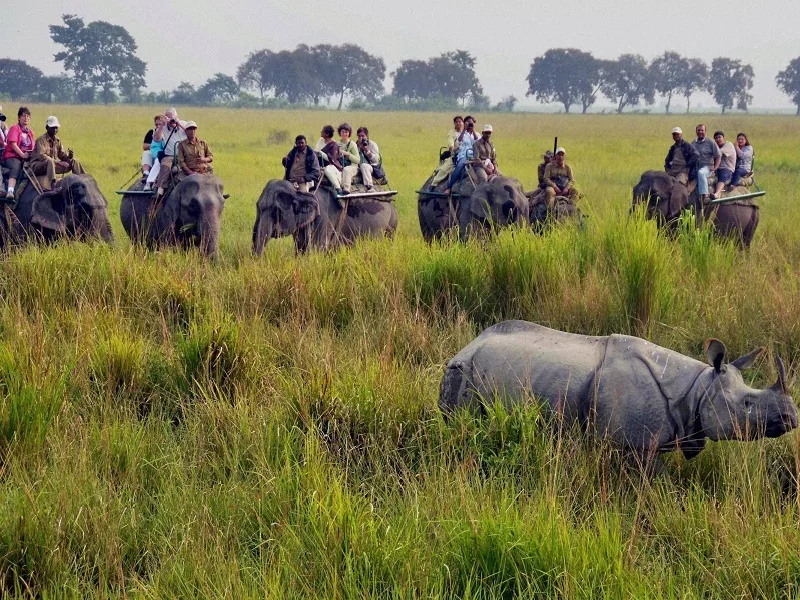
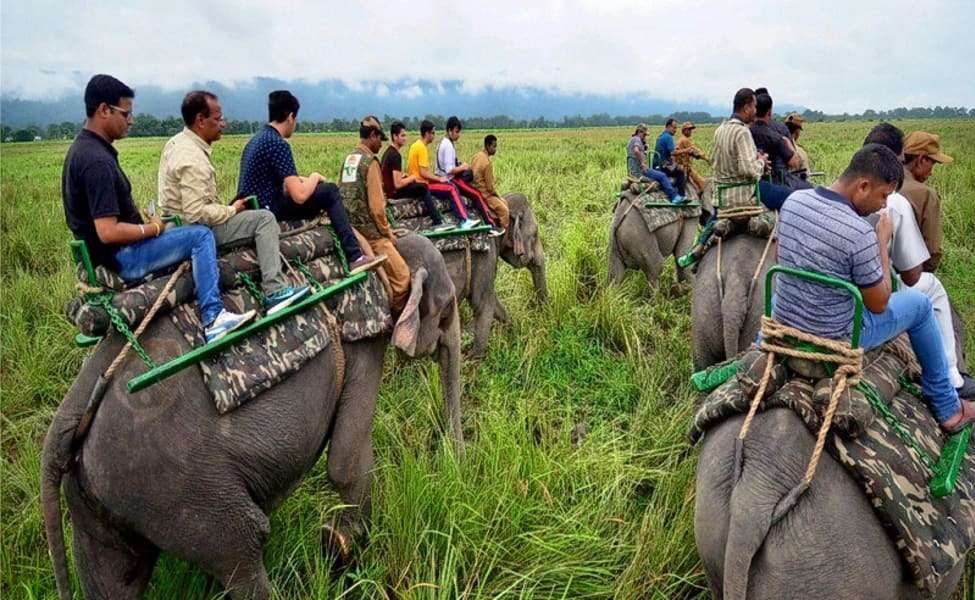
Popular Safari Zones in Kaziranga National Park
The primary safari zones that attract the most visitors in Kaziranga National Park include:
Kohora (Central Range) Safari Zone
The Kohora Zone in Kaziranga National Park is a must-visit core area, known for its abundant wildlife and stunning landscapes. You can enter through the central gate, just a kilometer from the National Highway, and embark on thrilling elephant and Jeep safaris from the Mihimukh riding point. This zone is famous for sightings of one-horned rhinos, wild buffalos, and swamp deer, as well as diverse birdlife like hornbills, owls, and fishing eagles. The large lakes in this area are a unique feature, where you might spot elephants cooling off. While tigers are elusive, there are always exciting tales to hear about them.
Safaris Allowed: Jeep and Elephant Safari
Bagori (Western) Safari Zone
Bagori, part of Kaziranga National Park in the west, can be accessed through the Western Bagori Gate on NH-37. It has expanded over the years, with a recent addition of 307 hectares in 2020. Bagori offers activities like organic farming and pisciculture around its small lakes. Known for eco-tourism and scenic watchtowers, the Donga area is famous for rhino safaris and is home to rhinos, deer, elephants, and diverse fish species.
Safaris Allowed: Jeep and Elephant Safari
Agaratoli (Eastern) Safari Zone
Bagori is the western part of Kaziranga National Park, accessible via the Western Bagori Gate on NH-37. Over time, it has expanded, with a recent addition of 307 hectares in 2020. Bagori is known for activities like organic farming and pisciculture due to its numerous small lakes. It’s a hotspot for eco-tourism with scenic views from its watchtowers. The Donga area is famous for rhino safaris and is home to a diverse wildlife population, including rhinos, deer, elephants, and various fish species.
Safaris Allowed: Only Jeep Safari
Burapahar Range Safari Zone
The Burapahar Range in Kaziranga National Park, the westernmost area, offers a stunning natural experience, best explored through jeep safaris. Surrounded by lush hills and tea gardens, it provides a picturesque setting. Located 40 km from the park’s central zone and accessible from Guwahati via Ghorakati village on National Highway 37, it’s the first zone you’ll encounter. Jeep safaris start from Rhinoland Park and include attractions like Patahi and Janata. This zone is ideal for birdwatching due to its many beels (wetlands), and it’s the only part of Kaziranga where trekking is allowed.
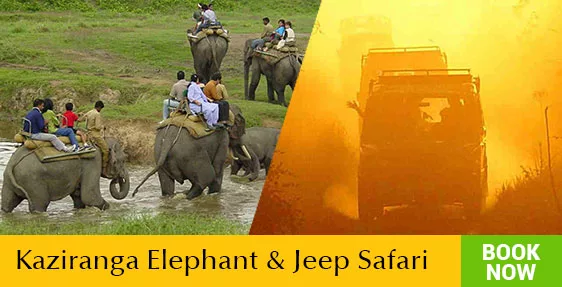
Safari Timings
For Jeep Safari : Jeep Safari is available from 1st November to 30th April every year and could be possible subject to weather and road condition on the months of May & October.
Morning Jeep Safari : 07: 09:30
Afternoon Jeep Safari : 01:30: 3:30
For Elephant Safari : Elephant rides are available from 1st November to 30th April every year that start in the early morning and continues for 1-1&1/2 hrs.
Elephant Safari Timings
| Range | Morning session | Afternoon session (NEW) |
| Burapahar Range, Ghorakati | 5:30 to 7:30 | 3:00 PM to 6:00 PM |
| Eastern Range, Agaratoli | 5:30 to 7:30 | 3:00 PM to 6:00 PM |
| Kazirana Range,Kohora | 5:30 to 7:30 | 3:00 PM to 6:00 PM |
| Western Range, Bagori | 5:30 to 7:30 | 3:00 PM to 6:00 PM |
Jeep Safari Routes
| Ranges | Routes Information | Km (Approx.) |
| Burapahar Range, Ghorakati | Ghorakati-Potahibeel-Diffalu-Tunikatiand back with designated stop at Tunikati Tower. | 17 Km |
| Eastern Range, Agaratoli | Agoratoli-Soholabeel-Rangamatia-Maklung-Turturani-Dhuba & back to Agaratoli to stop at Sohola Tower. | 22 Km |
| Kaziranga Range, Kohora | Mihimukh-Kathpora-Daflang-Diffalu river bank-Monabeel-Kerasing and back with designated stop at Kathpora Tower, Daflang Tower and Kerasing Tower. | 28 Km |
| Western Range, Bagori | Bagori-Dongabeel-Rowmari-Rajapukhuri-Mona Beeland back to Donga Tower. | 26 Km |
Trekking Routes:
| Ranges | Routes Information | Distance | Permission Required From |
| Burapahar Range(Ghorakati) | Kukurakata Reserve Forest: Natundanga through Kukurakata Reserve Forest up to Baneswar Temple and back. | 11 Km | Range Officer Burapahar Range, Ghorakati |
| Bokakhat Beat(Bokakhat) | Panbari Reserve Forest: Modarjuri Camp-Pipe line-Panbari forest & back to Modarjuri Camp. | 5 km | Beat Officer, Bokakhat Beat, Bokakhat |
Key Guidelines for Advance Online Safari Booking Procedure
- Provide the complete name, age, and gender of each guest as it appears on their ID, accompanied by the confirmation fee.
- Indicate your desired date of visit and choice of safari time (Morning/Afternoon).
- Submit a specific ID number (e.g., Voter ID, Aadhar Number, Driver’s License).
- All safari fees should be settled in advance.
- Ensure you carry the same identification used for the online booking.
- Foreign visitors must provide passport details for reservation.
- Safaris are assigned on a “first-come, first-served” basis, subject to slot availability.
Essential Guidelines for Your Kaziranga Safari Experience:
- Entry permits are mandatory and can be procured using the previously listed documents.
- The safari reservation process adheres strictly to the guidelines set by the Kaziranga National Park’s forest department.
- Jeep Safaris operate in two sessions: morning and evening.
- Elephant Safaris are also available in two sessions, both scheduled for the morning.
- Once issued, entry permits are non-refundable and non-transferable
- Only authorized guides can accompany your tours. Kindly refrain from substituting them.
- The National Park prohibits entry post-sunset.
- For your safety during a jeep safari, please remain seated in the vehicle at all times.
- We advise against bringing pets on your trip, as they are not permitted within the boundaries of Kaziranga Park.
- All guests at the Kaziranga Wildlife Sanctuary must adhere to the Wildlife Protection Act’s regulations. Your cooperation is appreciated.
- Acting as your booking agent for the safari, we cannot be held accountable for any incidents, injuries, thefts, or mishaps during the safari experience.
- Book in advance, as seat and zone confirmations depend on availability.
- An identity card is required for booking, while foreign visitors must provide passport details.
- The fare covers the Safari permit, vehicle, and guide fees.
- Consider accommodations near the park. Safari vehicles offer pick-up and drop-off services if you’re within 5 kilometres of the park.
- Select the ideal safari based on your preferences. While Jeep safaris provide a comprehensive park exploration, elephant safaris offer a more adventurous and relaxed experience.
- Arrive at the park at least 15 minutes before your scheduled safari.
- Adhere to wildlife guidelines to ensure a smooth and secure experience.
- Dress appropriately for the wilderness. Opt for comfortable attire, stay hydrated, and use sunglasses and hats for sun protection.
- Bring along equipment like cameras and binoculars to observe and capture distant wildlife.
- Pets aren’t permitted inside the park, so it’s best to leave them at home.
Flora:
Due to the difference in altitude between the eastern and western areas of the park, here one can see mainly four types of vegetation’ like alluvial inundated grasslands, alluvial savanna woodlands, tropical moist mixed deciduous forests, and tropical semi-evergreen forests. Kumbhi, Indian gooseberry, the cotton tree, and elephant Apple are amongst the famous trees that can be seen in the park. Also, a good variety of aquatic flora can be seen in lakes, ponds, and along the river shores.
Fauna:
The forest region of Kaziranga Park is home to world’s largest population of Indian Rhinoceros. Other animals that can be seen in the elephant grass, marshland and dense tropical moist broadleaf forests of Kaziranga are Hoolock Gibbon, Tiger, Leopard, Indian Elephant, Sloth Bear, Wild water buffalo, swamp deer, etc. With increase in tiger population every year, the government authorities declared Kaziranga as a Tiger Reserve in the year 2006. Also here one can find good number of migratory bird species from Central Asia.
Best Time to Visit
Kaziranga Park remain closed from 01 May till 31 Oct every year for the visitors. Therefore November to April is the best time to visit Kaziranga National Park.
- Summer (April to May): During this time of the year, the climate remains dry and windy; one can find animals around the water bodies.
- Monsoon (June to September): From June till September, the region receives heavy rain, approximately 2,220 millimeters (87 in); thus the climate remains hot and humid. The park remains closed from May to October due to warnings of Brahmaputra river floods.
- Winter (November to February): Perhaps the best time to visit the Kaziranga National Park as the climate is mild and dry. Chances of spotting rhinos are more in winter as the grass burn off and the background becomes clearer.
How To reach Kaziranga National Park –
By Air: The nearest airports are Guwahati (200 km) and Jorhat (100 km).
By Train: The closest railhead is Guwahati (200 km), and you can easily find cabs to Kaziranga from there.
By Road: Kohara, on NH-37, is the main entry point to Kaziranga. ASTC and private buses run from Guwahati, Tezpur, and upper Assam regions to Kohara.
